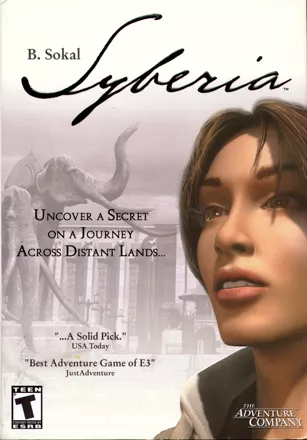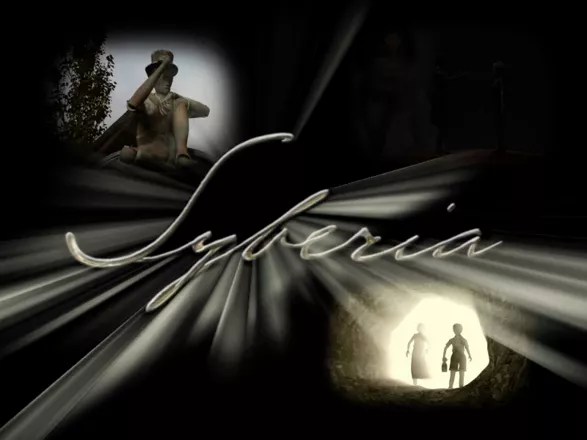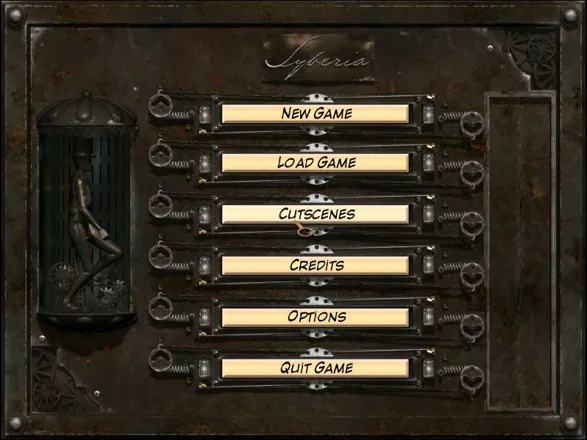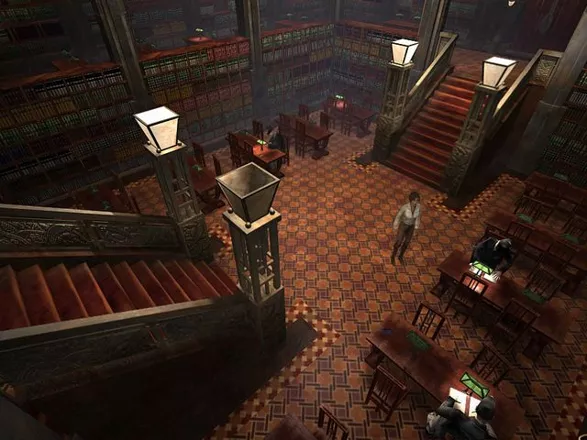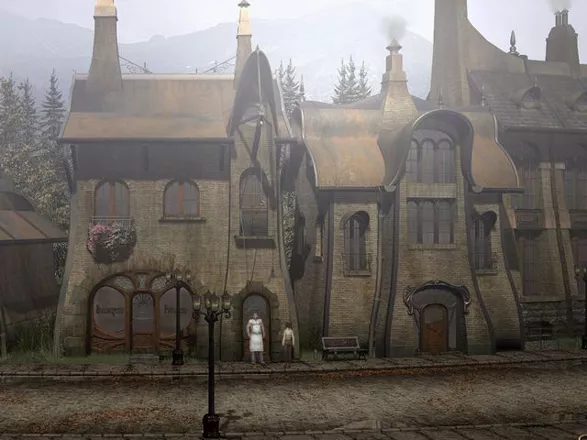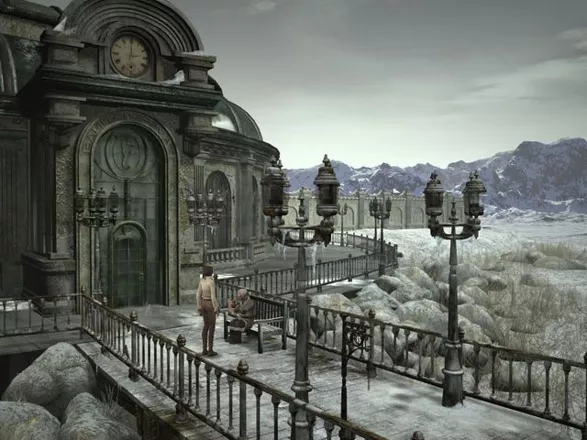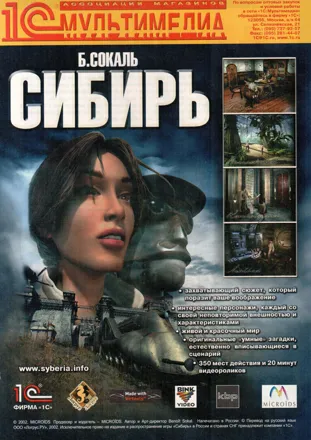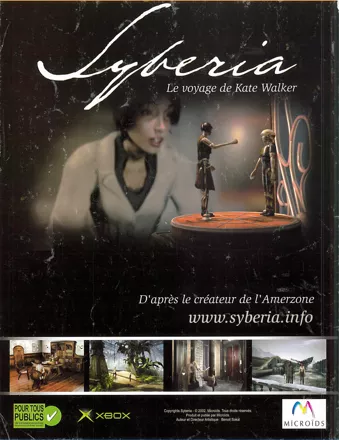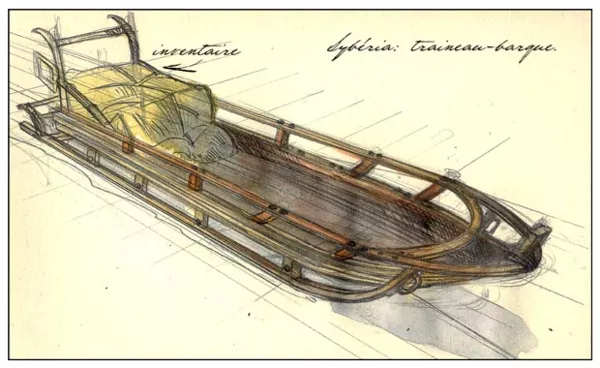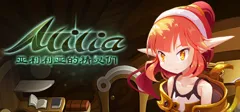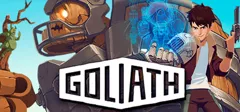Syberia
Description official descriptions
Kate Walker is a lawyer who has been entrusted by the Universal Toy Company to negotiate the takeover of an old luxury toy and automaton factory. Over the centuries, the factory has been developing clockwork devices, specializing in perpetual mechanical movement. The factory's ambitions, however, are ill-suited to the contemporary economic climate, and the elderly Anna Voralberg, at the helm of the Valadilene factory for more than half a century, has decided to sell up.
It turns out that the takeover might not be as straightforward as expected. The day that Kate Walker arrives, Anna Voralberg is being buried. What is more is that she has left an heir – her brother Hans. But Hans had left the valley at the end of the thirties and never returned, and was actually believed to be dead. However, a letter written by Anna in the days leading up to her death reveals that Hans is well and truly alive and living somewhere in Siberia. Valadilene's elderly notary entrusted to take care of Anna's affairs suggests that Kate find Hans Voralberg as he is now the only person in a position to ratify the sale of the family business.
Syberia is a traditional puzzle-solving adventure. The player navigates a 3D model of the protagonist over pre-rendered backgrounds with fixed camera angles. Puzzles are mostly inventory-based, though some involve manipulating the environment (such as mechanical devices). The interface features a single cursor; only highlighted objects can be interacted with, and there are no verb choice commands.
Spellings
- Сибирь - Russian spelling
- シベリア 日本語版 - Nintendo product page Japanese spelling
- 西伯利亞 - Traditional Chinese spelling
- 赛伯利亚 - Simplified Chinese spelling
Groups +
Screenshots
Promos
Videos
Add Trailer or Gameplay Video +1 point
See any errors or missing info for this game?
You can submit a correction, contribute trivia, add to a game group, add a related site or alternate title.
Credits (Windows version)
114 People (101 developers, 13 thanks) · View all
| Author | |
| Art Director | |
| Production Manager | |
| Technical Manager | |
| Project Manager | |
| Lead 3D Modeler & Texturing | |
| Lead 3D Animator | |
| Lead Programmer | |
| Lead Integrator | |
| France-Canada Coordinator | |
| Game Designers | |
| Writer/Editor | |
| Set Design | |
| 3D Modeling & Texture Art - Environment | |
| 3D Modeling & Texture Art - Characters | |
| Animation - Cutscenes | |
| Animation - In-game | |
| [ full credits ] | |
Reviews
Critics
Average score: 76% (based on 67 ratings)
Players
Average score: 3.9 out of 5 (based on 195 ratings with 14 reviews)
The Good
By now, Syberia has become one of the classics of an almost dead genre. Yet at its time, it was anything but that; it was a mad attempt to breathe life into a corpse. The problem, however, is that this breath of life was, in fact, terribly stale. While the game may be appealing to the newcomer, for seasoned adventure players, it's almost embarrassing. Consider this a rant on why Syberia is not a classic, or even a good game.
First things first, though: the game is gorgeous. The graphics have aged gracefully; the combination of 3D characters and prerendered backgrounds still looks very good (compared to Grim Fandango or The Longest Journey), while the backgrounds themselves are stunning. It's clear the prerendered images were meticulously touched up by hand, with a consistent art style, looking almost like a pencil drawing inked over. FMVs are a different kettle of fish, with wooden animations and a few ugly effects (oh, the explosions!), but the rest of it? Beautiful; and one of the best-looking games I have ever seen.
I also rather like the interface, which is a logical conclusion of the trend adventure games have been following for years: single button point and click. It's barebones, and gives an extremely limited control, but it is a clear, reasonable design decision and as such, I can get behind it.
Sadly, however, it is now time to move to the next section.
The Bad
Unusually for video games, Benoît Sokal has something of an auteur thing going on in Syberia. He's the lead designer of the game, but also a comic book artist, which explains a lot. As I have said, he certainly can draw, and he has an artistic vision. But he can't really write, and, worst of all, can't design games.
The soul of any adventure game is the writing. None of the true classics became a classic because of its puzzles, or its graphics, or anything else: it was always writing. And this is where Syberia fails tragically; and comic books are perhaps to blame. First of all, the story is simple. The whole thing can be retold in one paragraph, with nothing significant being omitted. American lawyer tries to find a missing, eccentric old man, whose eccentricity is an excuse for populating the world with all sorts of mechanical contraptions. That's pretty much it. It's a story worthy of speech bubbles, but certainly not branching adventure game dialogue. It also doesn't end; and I mean at all. Imagine listening to a story where the narrator suddenly pulls out a watch, looks at it, and says "Alright, so she went outside and there he was, sitting on a bench. Now go home." The ending gives a clear "to be continued in the next issue" vibe; and suddenly we learn the rather large amounts of backstory were just window dressing. Just an excuse to show more pretty pictures.
And regarding dialogue - there's nothing to write home about. There are characters in the game, and they talk. Everything about them is completely forgettable. There is just one exception of a dialogue that stands out: an old sailor who is talking in a hodgepodge of about five languages, curiously interpreted into English by his wife. The more of the languages you recognise, the more hilarious the exchange is. That's all, though, really. The dialogue system is simplistic, with a handful of the same, universal topics for every character, which certainly doesn't add any spice to it. It does the job. Full stop.
This single-purpose writing is actually one of the tell-tale aspects that reveal the true nature of Syberia's game design: things were put in just because adventure games, a genre Sokal has chosen for Syberia, usually have them. Their implementation is entirely superficial and often plain wrong. They are there just because a pure comic book videogame, where you would just keep clicking Next, would be too boring.
Yet this half-hearted implementation of the staples of the genre makes Syberia exactly that: boring. The game world is almost entirely dead. As I have said, visuals triumph here, which means the game is full of gorgeous, yet absolutely empty screens. My conservative estimate is that in about 70% of the game's screens, perhaps even more, absolutely no "gaming" is going on. They are there just to walk through. Every once in a while, a minor character is inserted into such a screen for local colour (and I do mean once in a while; there are about half a dozen of them altogether) who repeats the same mechanical response over and over again. The whole game is incredibly, mind-numbingly static.
And this brings me to the other major point, this one caused by something else than comic book design mentality. It takes a while before the penny drops, but the secret is that while the game pretends to be a classic third-person title, it is, in fact, a Myst clone. Gorgeous, yet empty and dull, fascinated by mechanical contraptions and puzzles that are not a part of the game world, but that exist only to be solved. It's quite obvious, really.
To put it simply, the puzzle design in Syberia is atrocious. It's an almost completely linear sequence of events, some of which are not connected at all yet have to be performed in the prescribed order, with copious amounts of backtracking through dead scenery. The train won't start because you haven't retrieved the MacGuffin yet. The train won't start because you have the MacGuffin in your inventory, but haven't put it in its proper place on the train (and after the train stops again, you'd better pick it up again, because you'll need it). Follow the numbers. Of course it makes no sense for your heroine to waste time doing this or that, but the story can't continue if you don't. The puzzles are not a part of the plot, they are added in, as an afterthought. The consequence, naturally, is that Kate is sometimes forced, by the twisted "there ought to be a puzzle here" logic, to do things in a needlessly complicated manner. There's a puzzle arising from the fact that she isn't willing to jump over a small brook, and another, involving running all over the place and talking to everyone who will listen, just because shooing away three cuckoos is apparently too difficult. The logic of the puzzles is twisted, yet the over-convoluted solutions are usually very apparent, because the extremely linear nature of the game means there simply is nothing else to do. And if the solutions aren't apparent, it's probably because you overlooked a hotspot in one of the screens which there was a good reason to consider useless. It's maddening; and I often caught myself wishing there was actually a "next" button to turn the pages of the comic book, skip a puzzle or two and view some more pretty imagery.
And that, to sum it up, is the sole reason why I can't consider Syberia a classic, its most peculiar characteristic: gameplay for gameplay's sake. It shouldn't have been a video game in the first place, that's what's wrong with it.
The Bottom Line
If writing is the soul of an adventure game, and puzzles are its flesh and bones, the only thing Syberia has going for it is a beautiful skin. Thinking back, there is nothing memorable about the game at all, except that it is gorgeous. And that's not even remotely enough.
Windows · by plumifrons (95) · 2010
Another otherwise creative game flawed by ridiculous and unlikely "adventuring".
The Good
The graphics are beautiful. I wish there was a way I could just sit back and watch a slide show of all the scenes in the game. They are some of the best I've ever seen, and the ambient sounds that went with it were just amazing. Almost immediately I was immersed in the atmosphere of this game.
Character models look great. A real improvement over past recent adventure games.
The cutscenes are also very beautiful. You even get to go back and watch them again on the main menu, which is something I did a few times.
The Bad
Allright, the story isn't that bad, and the cutscenes and in-game graphics are beautiful, but like many other recent adventure games, this game's biggest flaw is the completely unlikely method of completing puzzles and getting anywhere in the game. The story is something like, you find out that this company that you're trying to buy (or rather, a company you represent is buying this company) belongs to an heir that everyone thinks is dead (and the reason why is so mind-baffling stupid), so you must go find him and convince him to let you buy the company.
Well, that sounds like a nice adventure detective-type game. Now, if you were a lawyer trying to track down this heir, what would you do? Would you break into churches and rummage through peoples' dressers and dig up caskets and steal a train? Well that's pretty much this lawyer's method of "puzzle-solving".
That was by far the most annoying aspect of the game. And since there's no way around it (for God's sake, she's carrying around a cell phone! USE IT, WOMAN!) that's just what you have to do. But there are other, more minor parts of the game that I found to be annoying. Like some of the voice acting. This "Mumu" kid pisses me off. Whoever voiced him (or wrote his dialogue) should be smacked.
One part of the game REQUIRES you to draw a picture of a mammoth for this Mumu kid. Now, you have paper, you have a pen, why don't you just draw it? No, apparently you've never SEEN a mammoth, so you have to go find a picture of one. Didn't see the barely-visible picture of the mammoth on the wall? Well, you can't go any farther in the game until you see it so you can sketch it. I think I spent three days just wandering around every single part of the town looking for a way to go on with the game. I finally resorted to using a walkthru and discovered that there was this picture of a mammoth on the wall of an attic...I didn't see it when I was up there.
Now, some people might have seen it. I could have just been blind. But my point is, a lot of the puzzles in the game require you to have eagle eyes, to be able to scrutinize every single inch of the game for anything that you might have to use later. I play adventure games because, to me, they're like an "interactive movie". But I don't remember seeing any movies where the main character spends the entire show on his hands and knees on the dirt road searching for any sort of pebble that might be out of place.
The Bottom Line
I'd say, pick it up just for the incredible graphics. But for God's sake, can't they make an adventure game that requires you to do realistic things and complete puzzles that don't involve such mind-numbling scrutiny?
Windows · by kbmb (415) · 2003
The Good
Syberia was released to nearly-standing ovation from many fans of adventure games. Some went as far as to proclaim it the promised savior of the agonizing genre. So, what are the reasons for the overwhelming praise this game received from critics and players all around the globe?
Syberia was developed by a company that, by that time, had had some experience with adventure games; their previous works were Amerzone and Road to India. Syberia got rid of their "disturbing factors" (the overused Myst-like perspective and atmosphere of the former, the demo-like size and non-existent challenge of the latter) and expanded itself to become a more mainstream, full-fledged adventure game of the ever beloved third-person, point-and-click variety.
Though it does borrow a few elements from Amerzone, it cannot be denied that Syberia has a strong sense of style. That's its most appealing aspect, and that's how it managed to capture the hearts of so many players. The creators of the game let us enter a unique world. Usually, science fiction novels, movies or games are concern with either space travel or all kinds of futuristic machinery. The word "science fiction" becomes immediately associated with highly advanced electronics, spaceships, robots, and overly intelligent maniacal computer systems. But a "retro" science fiction of the beginning of the 20th century, science fiction in little quiet European towns of yesterday - that's quite unusual, and that's what Syberia is about. A strangely interesting world of automatons - mechanical robots - is definitely stylish. This is something no one has probably thought of before, and for that idea the game deserves credit.
A few of the locations are rather imaginative, with some interesting architecture and the elusive mechanical toys contributing to the peculiar charm. There are some nice gameplay elements here and there. You may rejoice at the occasional good, fulfilling puzzle and a bit of lively dialogue happening when you least expect it. I liked the idea of the protagonist communicating with her friends and family over the phone - particularly because that wasn't connected to any in-game activity and was there simply to flesh out the rather indifferently-acting main character a bit more.
Syberia has good production values. The pre-rendered background graphics are detailed and aesthetically very pleasing - though, in my opinion, the art is somewhat cold and cannot quite compare to the majestic beauty of the similarly-looking The Longest Journey. Also, everything is done in grayish tint - which is probably intentional, conveying the occasionally atmospheric, bleak solitude of the game's world.
The Bad
Syberia may be the next hippest thing in the world of 2D background art or even a clever metaphorical tale of human life for all I care, but it is not a good adventure game.
Most adventures live and die with their puzzles, and that's where Syberia fails utterly. There is no spark or inspiration in the puzzles at all. After you finish the game, only the cocktail preparation and perhaps one or two other tasks would linger in your memory for a while. Everything else is forgettable at best, and more often irritating. The mechanical puzzles are uniformly dull; inventory-based activities come across as pathetic shadows of the merry experimentation we knew from the comedy adventures of yore. Worse, however, is the fact that most objectives force you to run back and forth through lifeless landscapes from a solitary character to an obscure item well-hidden in the backgrounds, to an extent rarely seen in the classic representatives of the genre due to the game's abysmal linearity and lack of interaction. Even more so than other contemporary adventures, Syberia discourages experimentation and any kind of creative thinking; it contains almost no optional actions at all, grabbing your hand and sending you on an on-rails museum tour, occasionally sticking your nose into a puzzle that has to be solved here and now.
The puzzles are also poorly balanced. You encounter them virtually in every location you visit, and many of them are elementary easy to solve right away. As a result, you are able to actually solve many puzzles without even knowing that. Since you can't get stuck or die in the game and there are usually only very few things the game allows you to do, the puzzles often refuse to follow the cardinal rule of logic (first find out why you need to do something, then do it). Because of that, most puzzles feel like amateurish imitations of classic gameplay devices pasted into the game without a good reason.
The story of Syberia starts strong, but unfolds itself much too slowly. There is absolutely no sense of urgency in the development of the plot. It is as if the designers decided that the stylish setting alone would be enough to guarantee good storytelling. The whole game is spent overcoming ridiculously irrelevant obstacles while searching for a missing person. You could sum up this story in a couple of sentences. Nothing really significant happens in the game. True, the ending is not bad compared to the rest of the game, but to suffer hours of unexciting gameplay without any real story advancement just in order to see this ending is a bit exaggerated.
Syberia is also a very dry game. It sorely lacks emotions. Its attempts at humor are infantile at best. Its characters feel artificial and uninspired. You know there is a problem with the character cast of a game if its most interesting character is a mechanical robot, and even he comes across as forced with his uneasy goofiness. And all those dry characters will force you to engage in equally dry conversations with them. There's a lot of dialogue in the game, and almost all of it is dull. Almost the only exception I can think of is that guy hitting on Kate in different languages.
The Bottom Line
Syberia was met with joy by critics and players alike. People were longing for an adventure game, and this one was undoubtedly better than most of its genre cousins released at that time. To me personally, the success of this game only highlighted the gravity of the death sentence imposed on adventures. It's the story of The Longest Journey once again - except this time involving a lesser game.
Windows · by Unicorn Lynx (181775) · 2014
Discussion
| Subject | By | Date |
|---|---|---|
| Who Was the Model for Kate Walker? | null-geodesic (106) | Dec 1, 2007 |
Trivia
Language
The words written on the control panel of the airship in Kolmkozgrad are authentic Russian. However, the name of the hotel in Aralbad is written incorrectly.
Marketing
Some German games magazine editors received a postcard from New York with a handwritten text from someone called Kate who wrote in German, that she had an Austrian uncle, some problems and so on. There was no clue that this was a PR-event for the game Syberia, even the fake-handwriting was done with some smeared ink.
PlayStation 2 version
Contrary to the Xbox release, the PS2 version did not appear in North America, as SCEA did not approve the game there.
References
- The rat from Road to India makes a cameo appearance in Syberia. It appears in the basement in Kolmkozgrad, makes exactly the same movements it did in Road to India, and disappears.
- Syberia contains some references to another game by Microids, Amerzone . In Barockstadt you can read and hear a lot about different species of Amerzone's flora and fauna.
Awards
- Computer Games Magazine
- March 2003 (Issue #148) - #10 overall in the "10 Best Games of 2002" list
- Computer Gaming World
- April 2003 (Issue #225) – Adventure Game of the Year
- Gamespot
- 2002 - PC Adventure Game of the Year
- 2002 - Best Artistic Graphics
- Gamespy
- 2002 - PC Adventure Game of the Year
- IGN
- 2002 - Best Adventure Game (Readers' Choice)
Information also contributed by Felix Knoke, Jeanne, PCGamer77 and Sciere
Analytics
Upgrade to MobyPro to view research rankings!
Related Sites +
-
Another good walkthrough
MaGtRo's Walkthrough for Syberia -
Microids' Official Walkthrough (in English)
Original walkthrough published by the developer -
Microids' Official Walkthrough (in French)
Original walkthrough by Microids in French -
Solution in Hint Form
If you'd rather get subtle hints to help you along, this file will get you to the solutions at your own pace. -
Syberia
Official Site - Adventure Company -
Walkthrough
If you get stuck in game, use this site to help you out of trouble and continue playing. -
Walkthrough by Witchen
Witchen's Syberia solutions -
Zarf's Mini-Review
A mini-review of Syberia by Andrew Plotkin (March, 2004).
Identifiers +
Contribute
Are you familiar with this game? Help document and preserve this entry in video game history! If your contribution is approved, you will earn points and be credited as a contributor.
Contributors to this Entry
Game added by Isdaron.
Nintendo DS, PlayStation 3 added by Charly2.0. Linux added by Plok. Android added by Ingsoc. Nintendo Switch added by Kam1Kaz3NL77. Xbox 360 added by Kennyannydenny. iPad, Blacknut, PlayStation 2, iPhone added by Sciere. Xbox added by LeChimp. Macintosh, Windows Mobile added by Kabushi.
Additional contributors: frin, Unicorn Lynx, Jeanne, tarmo888, Sciere, Zeppin, Paulus18950, Patrick Bregger, Rik Hideto.
Game added June 28, 2002. Last modified April 2, 2024.
